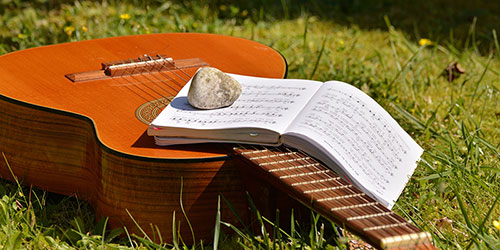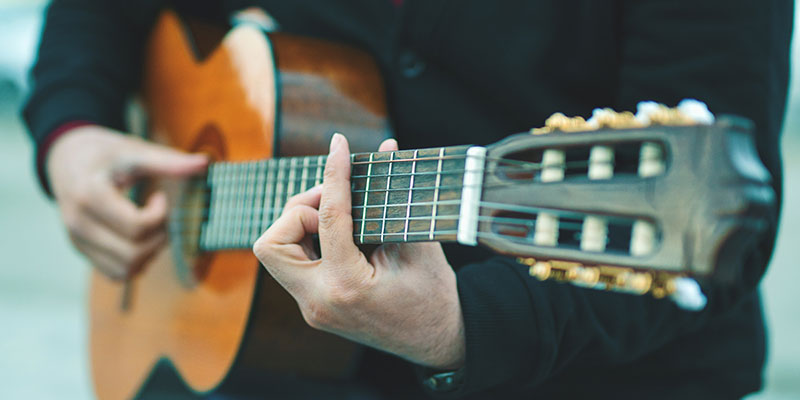How to Learn Guitar
Once you’ve become pretty good with the Lesson -1 and Lesson-2, you can now get to the real deal. Below are several things you might need for learning guitar. Different types of advanced method and playing technique are also described here. The amount of practice time you’ll invest will also have an impact on developing your skills.
Material and Accessories for Further Learning
You will need at least one cover properly padded to carry your guitar, as well as some picks (soft are easier to use than hard). An electronic tuner is an extremely useful purchase – if not essential! – It is to obtain an always flawless tuning, as well as a set of spare chords in case of rope breakage.
In the case of an electric guitar, you will obviously also have to get a jack cable and an amp so you can hear you play. There are many amps, called combos, for less than 100 USD. Recently, the musical instrument companies have also developed small pocket amps that can be used with a simple headphone: it is very convenient to play everywhere, without disturbing your neighborhood!
Finally, even if it is not essential, you can consider the acquisition of a metronome (a device that gives the tempo in an automated way). These machines are interesting because they help to play in rhythm.
How to Strum a Guitar
On this lesson, we will equip you with all the skills you require in order to play your guitar well.
It is important to understand chords and notes and their differences. A note is a pitch that is solitary and it is the sound that you hear once you pluck one of the strings. A chord is what you hear when you play a group of notes at the same time. An example of playing the chords is strumming G, E and B strings at once. Beginners should start by knowing how to play the chords. For better understanding, notes are like a single letter while chords are like words which are several letters put together.
All beginners require to practice more with their guitars. Practice is very important because it helps beginners grow their skills and expertise. One important thing that every beginner should learn is how to strum a guitar. This is a skill that will help them practice safely without injuring their fingers. Strumming a guitar requires beginners to use their picking hand. There are several ways of strumming a guitar. These include using a pick and using your fingers
Using a pick to strum your guitar
To strum your guitar using a pick, you need to learn to grip your pick nicely. It is also necessary for beginners to know the most convenient angle to strum their guitars at. When strumming your guitar, grip your pick and ensure the sharp end is facing towards your left-hand side. Gently place the right thumb the pick and grip it naturally.
Strum the guitar in the most comfortable way possible. It is worth noting that it is much easier to learn guitar when beginners play using a pick. However, strumming a guitar using picks limits a beginner on the kind of music they play with the guitar. Picks will not allow you to play all textures. Using picks, a guitar player has the ability to play several strings simultaneously provided they are located closely.
Fingerpicking
There are several fingerpicking techniques that every beginner should learn. Fingerpicking requires the player to use the first three fingers of the right hand to pick guitar strings. The player should place the thumb on the pick then move it downwards. Upstroke and down strokes come out perfectly when the learner is at the most comfortable picking angle. However, the overall performance of a guitar learner is determined by the player’s position. The following steps will enable you to learn how to finger pick your guitar more easily;
- Place the thumb of the right hand on the sixth string.
- The first finger of the right hand should be put on the third string.
- On the second string, place the second finger of the right hand.
- Lastly, the third finger of the right hand should be on the first string.
Beginners can practice this pattern as many times as they can in order to master the technique.
While practicing fingerpicking, it is important to maintain your fingers in a curved position. However, it is advisable to hold the picks in a position that feels more natural and comfortable to your hands. Some players prefer fingerpicking with their hands parallel while others prefer doing it with their hands curved in.
While strumming, the angle you strum at is also very important. In most cases, people strum the guitar with the pick in a downward angle. Other people prefer strumming with picks at an upward angle or even in a parallel pick angle. It is a matter of identifying the angle that works best for you.
Having a perfect posture for playing the guitar
- Do not lean on a low sofa. Once you slump in a low sofa, your movement will be restricted hence making it difficult to play the guitar. Whatever that you sit on is very vital when playing your guitar. Remember, your position or posture is very important when playing the guitar.
- Do not sit on a chair that has arms. Sitting on such a chair is terrible when playing guitar as it will restrict your movement. The left elbow will be tucked in the torso. When learning how to play the guitar, your left hand should be completely free of any obstructions.
- Do not sit on a high stool. The stools that are low are perfect because the high stools will make the thighs to slope downwards hence the guitar will be slipping away when playing. When learning how to play this instrument you should always ensure that the guitar is safe.
- You can choose to sit on anything as long as your knees are at an angle of 90 degrees and that the two hands are free and obstructed by nothing. With this, you can learn to play the guitar quite fast and without any frustrations.
Different Playing Techniques and Tabs
The wrist of the right hand must be soft to obtain a pleasant sound. Then we move to arpeggios using the thumb, forefinger, middle finger and ring finger (finger picking) or more often the pick (flat picking). Finally, we are ready for improvisation and the creation of more personal melodies. Note that solo note-to-note and improvisation are much more common here.
A play method/technique must still allow playing quickly known pieces to use the techniques learned and especially to have fun. This is valid in acoustics as in electrical. Playing the standards of blues, rock, metal, reggae, funk or jazz is an essential foundation of the pedagogy. Again, the choice of songs is fundamental because you do not have to grill steps and learn titles within reach by gradually increasing difficulties.
Conclusion
In conclusion, all first beginners in guitar classes should understand that there are many notes on the guitar and any beginner who may decide to learn all the chords at the same time it can be overwhelming. They should therefore first focus on the chords as learning all notes can be very frustrating. Learning how to play guitar is easy and interesting. All you need to do is pay attention and follow the steps as outlined in our lessons. Catch up with us in our next lesson and get more important tips on how to play the guitar.


